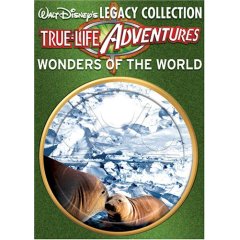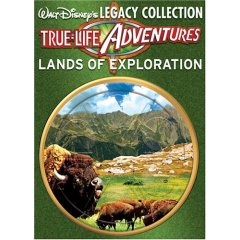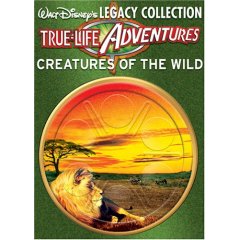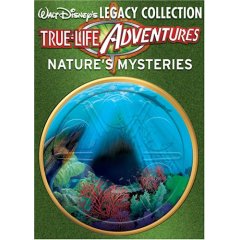
COMMENTARY
Truthiness
I've had a good time recently watching the four new "Walt Disney Legacy Collection " DVD sets devoted to Disney's nature films, the True-Life Adventures. That series began with the short subject Seal Island in 1948 and ended with Jungle Cat, the sixth True-Life feature, in 1960. My enjoyment has come not so much from watching the True-Lifes themselves—although most of them look terrific in remastered versions —as from watching the abundant supplementary materials.
 I saw all the True-Lifes while I was working on The Animated Man: A Life of Walt Disney, mostly at the Library of Congress but also on videotape. My skepticism about the series can be summed up by quoting my notes from a viewing of Seal Island at the LC in 2004: "Already here, there's some of the evident manipulation of film to force it into a story form, as with a pup that can't find its mother. The cutting, the multitude of angles, the closeups and long shots—all argue that the 'story' has been at least as much manufactured as recorded, taking advantage of the indistinguishability of most of the animals."
I saw all the True-Lifes while I was working on The Animated Man: A Life of Walt Disney, mostly at the Library of Congress but also on videotape. My skepticism about the series can be summed up by quoting my notes from a viewing of Seal Island at the LC in 2004: "Already here, there's some of the evident manipulation of film to force it into a story form, as with a pup that can't find its mother. The cutting, the multitude of angles, the closeups and long shots—all argue that the 'story' has been at least as much manufactured as recorded, taking advantage of the indistinguishability of most of the animals."
In Seal Island, as in other films in the series, the impulse to tell a story—or, as the Disney people preferred, to entertain—was of overriding importance. A great many sins were committed in entertainment's name, through the manipulation not just of film but also of the animals themselves. What's most revealing (or, really, entertaining) about the "Filmmaker's Journals" that are part of each two-disc set is that they tell us so much about what that manipulation involved.
For example, I took it for granted that the soundtracks of the True-Lifes were post-synced; they really had to be, given the difficult circumstances under which the photographers worked. What I didn't realize was that the animal noises we hear were not just post-synced but often came out of a human throat, that of the late Jimmy Macdonald, the wonderful sound effects expert who contributed so much to the Disney cartoons (including Mickey Mouse's voice from the mid-1940s on). That growling bear, that squawking penguin—their voices are Macdonald's, and if he didn't know what kind of sound a particular creature makes, he'd invent a plausible-sounding screech.
Likewise, it's evident from watching the movies themselves that film has sometimes been heavily manipulated, through reverses and repeats, for example, or blowing up part of a frame. The goal was usually a better fit with Paul Smith's music. On the DVDs the film editor Stormy Palmer describes some of the tinkering that was involved. It's less obvious that the animals were managed so they would behave in a certain way; but they frequently were. Some of that manipulation was described even during Walt's lifetime, in Jack Couffer's highly enjoyable 1963 memoir Song of Wild Laughter. (Couffer was a photographer and director for a number of the Disney nature films.)
As Couffer puts it, "Only rarely does an animal perform a dramatic part of its life in a situation where a man with a camera can photograph it. Sometimes it is necessary to induce the animal to re-create a natural action in a situation where it can be filmed. It is sometimes possible, for example, to condition night-living animals to behave naturally under the glare of photographic lights; it is sometimes even possible to teach digging animals to live their lives in cut-away burrows. These processes actually are only a restaging of the animal's natural way of life." 
The Journals suggest that such "restaging" often went much further. If, for example, connecting footage was needed to fill out a story, action might be invented to achieve the desired result. "You have to go out and try to get it all in the wild," the photographer Lloyd Beebe says in a 1985 interview, speaking of the filming of Jungle Cat. "But you can't, because you haven't completed things. You've shot a few scenes, and they aren't connected. Somehow you've got to get the scenes in between to make it work. ... Eventually we'd have to go somewhere and get us a jaguar and finish up what we missed." Tame animals sometimes doubled for wild animals. As might be guessed from the camera angles, the falcon swooping down on the prairie dogs in Vanishing Prairie is a trained bird; the prairie dogs are in no danger.
Jimmy Macdonald and other deceased participants in the True-Lifes are seen in interviews filmed in the 1980s —for a Disney Channel "family album" or something or the sort, perhaps? I really don't know. The copyright for the Journals is in the name of the Academy of Motion Picture Arts and Sciences, and perhaps that goes some way toward explaining why they're so open about the True-Lifes' compromises and evasions. But Roy E. Disney is present, too, in new footage, and he is remarkably frank about how the films were made. He is, as a result, more likable and interesting than I've ever seen him.
I was familiar with Roy's story about how the True-Life team generated footage of a duck sliding on ice for The Vanishing Prairie—footage that Walt himself insisted he'd seen and demanded be put in the film, but that didn't exist, at least until the True-Lifers tossed a duck at some other ducks on a frozen pond. But here that story is funnier and more detailed than before. (Roy suggests that Walt knew the footage didn't exist. Insisting that it did may have been his roundabout way of ordering the True-Lifers to go out and fake it.)
There were troublesome aspects to all this good-natured hokum. One was that the films pretended to be purer than they really were. A title card for Seal Island, for example, declares: "These films are photographed in their natural settings and are completely authentic, unstaged and unrehearsed." That was, to be charitable, an overstatement, and by the time of Water Birds (1952), pieced together from footage bought from a host of photographers, the language had been massaged a little: "In the making of these films, nature is the dramatist. There are no fictitious situations or characters." Well—yes and no.
A larger problem was that Disney's photographers often brought back, from what was sometimes years of arduous shooting in the wild, film that was better than the stories concocted from it. There's riveting footage in both The Vanishing Prairie and White Wilderness of predators (a cougar, a wolverine) stalking vulnerable young (a fawn, a fledgling osprey). Nothing else in either film compares with it. But the drama is of the most basic kind—animals trying to kill and eat other animals, nature red in tooth and claw. When the True-Lifers gave over a whole feature to such a generally truthful vision of nature, as they did in The African Lion and Jungle Cat, the results were much starker than the Disney norm. 
Lion is gory—who knew a wildebeest could be torn into so many tiny bits?—but in Cat the claustrophobic jungle setting heightens the sense that every creature is in a desperate hurry to eat every other creature that comes within reach. Crocodiles, boa constrictors, sloths—all are fair game for the film's stars, the jaguars, who look pretty tasty themselves to some of their prey. However admirable such a film, spending seventy minutes watching it can make one long for the clowning otters and dancing scorpions of earlier and less authentic True-Lifes.
The people who shaped the True-Lifes—Ben Sharpsteen, James Algar, Winston Hibler, the composer Paul Smith—all earned their Disney spurs working on cartoons, and so telling stories came naturally to them. Shifting from the True-Life Adventures to fiction films using real animals was thus an appealing way to escape from the dilemma that, ironically, became more acute as the True-Life features presented nature more realistically and thus became less vulnerable to criticism.
There's one such fiction film in the new DVD sets, the 1957 "True-Life Fantasy" called Perri. Disney never used that label again, although he made a string of animal films that were closer kin to Perri than to the True-Lifes. Because Perri was a "fantasy," the manipulation that was such an awkward element in the True-Life Adventures could be acknowledged openly, and it was even the subject of a Disneyland TV show that's also included on one of the DVDs. Unfortunately, the TV show asserts, altogether unbelievably, that only one female squirrel played Perri, and only one male squirrel her paramour. Presumably the truth would have been too hard for Disneyland's young viewers to take.
Perri itself invites comparisons not just with the True-Life Adventures, but with Bambi (which was, like Perri, based on a book by Felix Salten). The blend is awkward, to say the least, because the film evokes the True-Lifes mainly through scenes of bloodshed (a marten pursues and kills Perri's father), whereas Bambi is recalled through such high-sugar elements as a "winter fantasy" and a song for the mating season called "Together Time."
Later Disney animal films, like The Legend of Lobo (1962; not part of these sets), avoid such grotesqueries, but in watching them I'm always aware that the animals are actors—they're tame animals, impersonating their wild relatives and doing what they've been trained to do. It's not at all clear that wolves, say, would behave the same way in the wild. Jack Couffer's book includes a fascinating chapter on the filming of Lobo, which took a year and a half; the wolf stars were hand-raised from the time they were cubs.
James Algar, Lobo's co-producer (with Walt) and in earlier years the writer and director of the True-Life Adventures, wrote in a 1953 promotional booklet that "narration is kept to a minimum" in the True-Lifes: "Tell the audience only what is necessary to enhance their appreciation and enjoyment of a scene or situation; tell no more." But the narration in Lobo, as in other post-True-Life Disney animal films, carries a great deal of the load; as Bosley Crowther wrote in the New York Times, "the narration ... cheerily endows the wolf with a great deal more charm and character than is evidenced on the screen." One side effect of spelling everything out in the narration was to cement such Disney films into place as children's fare. 
Walt Disney always had trouble putting real life, animal or human, onto the screen. (The People and Places series, which I'm guessing will be part of the Legacy Collection soon, is even more problematic than the True-Lifes.) It's fortunate for us, and for his stature as an artist, that he had so much surer a hand when he was making cartoons.
A few words of caution: Some copies of the first and fourth sets in the True-Life series were released initially with mastering errors. In Prowlers of the Everglades, in the first set, the red and blue elements were reversed, producing strange colors. In Secrets of Life, in the fourth set, the final scenes should open up for a wide-screen effect, but in some copies those scenes appear in a pan-and-scan version. Disney home video had the correct masters but someone neglected to use them. The same thing evidently happened with the new Silly Symphonies set in the Walt Disney Treasures line. In other words, Disney has what appears to be a chronic quality-control problem, one I hope will be definitively addressed soon.
My copies of all these sets are defective; I've spoken with Disney home video, and I hope that eventually I'll receive replacement discs. If you buy any of the affected sets, be sure to watch them immediately and return them to the retailer if they're bad. There is, alas, no hope for any correction of the Legacy Collection's packaging, which has to be the most cumbersome DVD packaging I've encountered.
(As for the title of my review, I am of course indebted for it to my hero, Stephen Colbert.)
[Posted February 5, 2007; slightly revised, May 11, 2009]